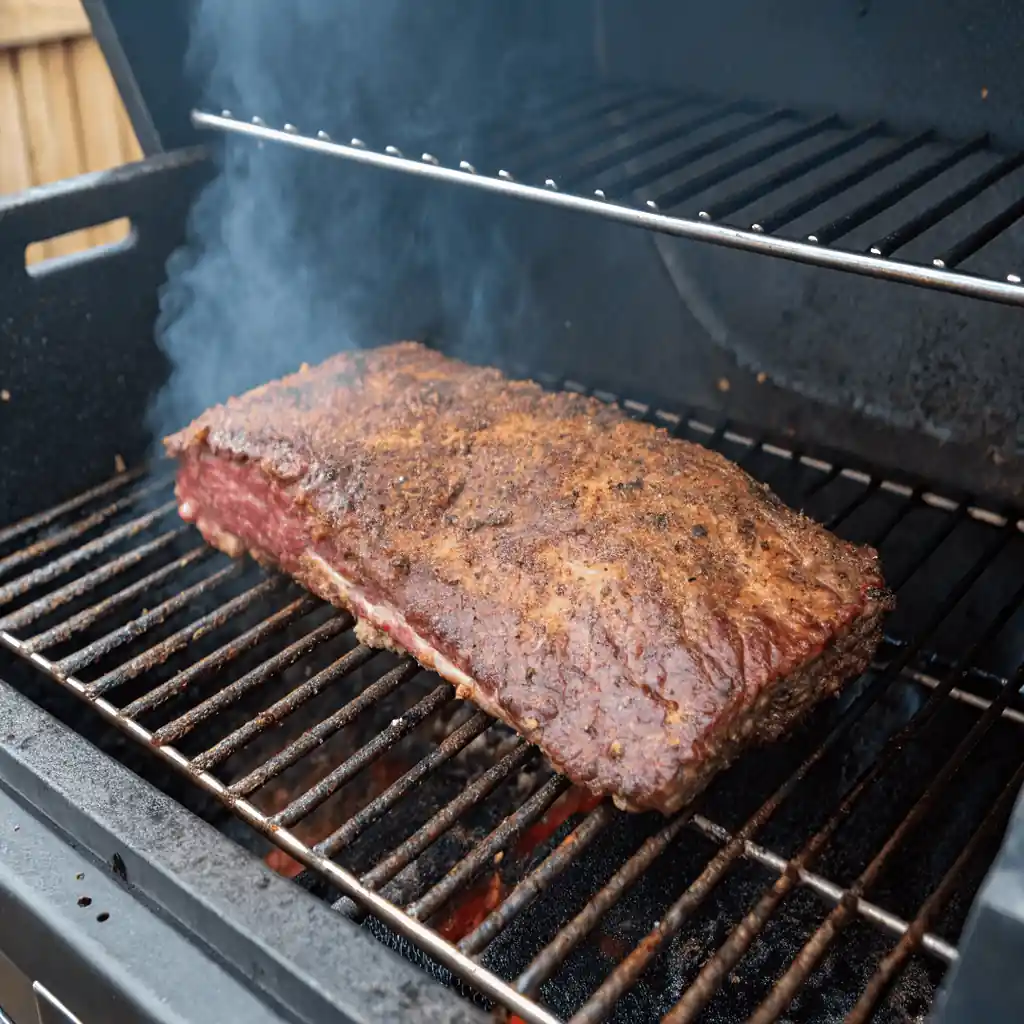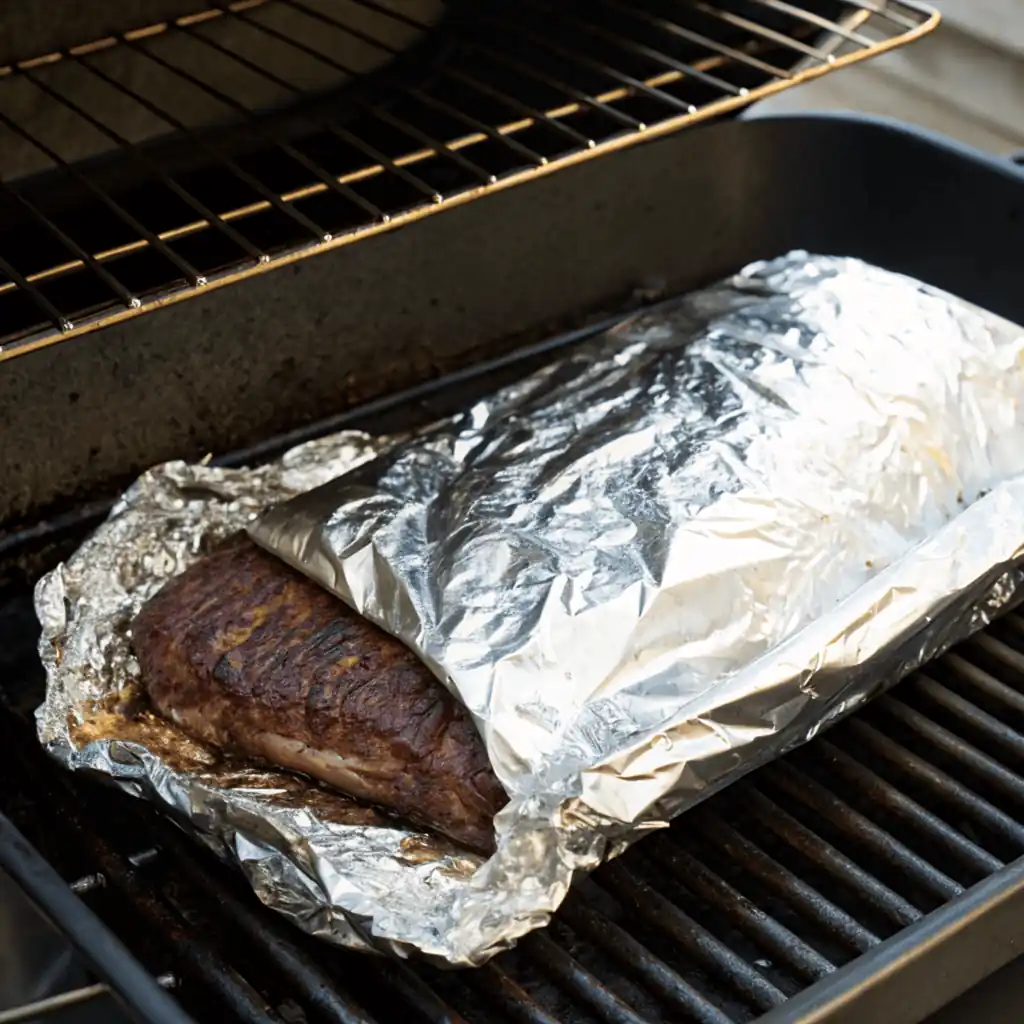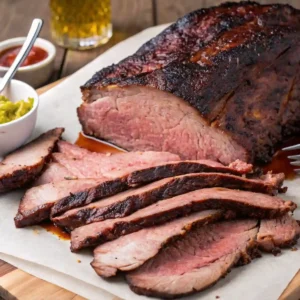How and When to Wrap a Brisket A Simple Guide for Beginners

An emotional brisket wrap isn’t just about technique; it’s about timing. I remember the shared anxiety, the collective decision with family and friends: “Is it time?” The moment the foil sealed, it felt like tucking in a loved one, a shared breath held until the final, tender reveal. Each slice, a memory.
Why You’ll Love Guide When to Wrap a Brisket
- Perfectly Tender Results: Achieve that sought-after, melt-in-your-mouth brisket every time.
- Enhanced Bark & Flavor: Learn to balance smoke penetration with moisture retention for incredible taste.
- Reduced Cook Time: Wrapping strategically helps accelerate the cooking process without sacrificing quality.
- Increased Moisture Retention: Say goodbye to dry brisket; this method locks in juices for succulent meat.
- Foolproof Consistency: Take the guesswork out of wrapping, leading to consistently excellent outcomes.
Table of Contents
Ingredients for when to wrap a brisket
Primary Ingredients

- Beef Brisket (12-16 lbs whole packer brisket)
- Why it matters: The size affects timing for when to wrap a brisket
- Alternative: Brisket flat (8-10 lbs) for smaller gatherings
- Kosher Salt (¼ cup)
- Purpose: Creates the foundation for bark development before wrapping
- Alternative: Sea salt or coarse salt
- Coarse Black Pepper (¼ cup)
- Function: Essential for traditional bark formation
- Substitute: Fresh cracked pepper for more intensity
Wrapping Materials Options
- Butcher Paper (unbleached, food-grade)
- Best for: Maintaining bark while tenderizing
- Heavy-Duty Aluminum Foil
- Best for: Maximum moisture retention
- Parchment Paper
- Best for: Lighter wrapping option
Time Needed to when to wrap a brisket
Total Time Investment
- Preparation Time: 30 minutes
- Smoking Time: 8-12 hours (varies by size)
- Post-Wrap Cooking: 4-6 hours
- Resting Time: 1-2 hours
when to wrap a brisket Step-by-Step
Step 1: Pre-Smoke Setup

Apply your favorite rub generously, focusing on even coverage. Allow the seasoned brisket to reach room temperature while your smoker preheats to a steady 225°F. This temperature consistency is crucial for predictable timing.
Step 2: Early Smoking Phase

Place brisket fat-side down on the smoker grates. During these initial hours, resist the urge to open the smoker frequently. The brisket will develop its signature bark as surface moisture evaporates and proteins form a crust.
Step 3: Monitoring the Critical Wrap Window
This is when to wrap a brisket becomes crucial. Watch for these four key indicators:
- Internal temperature plateau at 150-170°F lasting 2+ hours
- Deep mahogany bark that feels firm when touched
- Temperature stall where progress seems to stop
- Visual cues: The surface should look dry and darkly colored
Step 4: The Wrapping Technique

Work quickly to minimize heat loss. Remove the brisket and wrap tightly in butcher paper or heavy-duty foil. Ensure all edges are sealed to trap moisture and steam. Return immediately to the smoker.
Step 5: Post-Wrap Phase
The wrapped brisket will cook faster, typically reaching the target 203°F internal temperature in 4-6 hours. Use a probe thermometer to check tenderness – it should slide through like soft butter.
Step 6: Essential Resting Period

Keep the brisket wrapped and place in an insulated cooler. This resting phase allows juices to redistribute throughout the meat, ensuring maximum tenderness when sliced.
Tips for the Best when to wrap a brisket
Expert Timing Advice
- The Stall Strategy: Understanding when to wrap a brisket during the stall (150-170°F) is crucial for moisture retention
- Bark Priority: If bark development is your goal, wait until 165°F before wrapping
- Competition Timing: Pros often wrap at exactly 160°F for optimal tenderness
Temperature Mastery
- Use multiple probes to monitor different sections
- Account for thermal mass – larger briskets need different timing
- Environmental factors affect when to wrap a brisket decisions
Material Selection Tips
- Butcher paper: Better bark retention, allows some moisture escape
- Foil: Maximum tenderness, softer bark
- Double-wrap for extra-long cooks
Serving Suggestions
Classic Presentations
- Texas Style: Thick slices with simple sides (beans, coleslaw, pickles)
- Sandwich Style: Chopped brisket on brioche with BBQ sauce
- Burnt Ends Transformation: Cube the point for crispy burnt ends
Creative Serving Ideas
- Brisket tacos with fresh pico de gallo
- Loaded baked potatoes with chopped brisket
- Breakfast hash with brisket and eggs
- Asian fusion bowls with pickled vegetables
Pairing Recommendations
- Bold red wines (Cabernet Sauvignon, Malbec)
- Craft beers (IPAs, stouts)
- Classic BBQ sides (mac and cheese, cornbread)
How to Store and Reheat
To store, cool cooked brisket swiftly, then wrap tightly in foil and store in an airtight container. Refrigerate up to 4 days or freeze for 3 months. For reheating, the oven or sous vide is ideal. Heat foil-wrapped brisket (with a splash of broth) at 250-325°F (120-160°C) until 165°F (74°C) internal, or use a 140-165°F (60-74°C) sous vide bath. Avoid microwaving.
More Great brisket Recipes
- Chopped Brisket: The Best and Easy Sandwich Recipe
- Pikes Peak Roast: 5 Secrets to the Best Flavor
- Sliced Beef Brisket: The Ultimate Guide to Juicy Flavorful Results
- Brisket Mac and Cheese
- Smoke Brisket At 180 Or 225
- smoked corned beef brisket
- How to Smoke a Brisket on a Pellet Grill
- How & When To Wrap Brisket
Nutritional Information
Macronutrient Breakdown
- Calories: 280-320
- Protein: 28-35g
- Fat: 18-22g
- Carbohydrates: 0-2g (from rub)
- Sodium: 320-450mg

How and When to Wrap a Brisket A Simple Guide for Beginners
Ingredients
- Beef Brisket 12-16 lbs whole packer brisket
- Kosher Salt ¼ cup
- Coarse Black Pepper ¼ cup
- Butcher Paper unbleached, food-grade
- Heavy-Duty Aluminum Foil
- Parchment Paper
Instructions
Step 1: Pre-Smoke Setup
- Apply your favorite rub generously, focusing on even coverage. Allow the seasoned brisket to reach room temperature while your smoker preheats to a steady 225°F. This temperature consistency is crucial for predictable timing.
Step 2: Early Smoking Phase
- Place brisket fat-side down on the smoker grates. During these initial hours, resist the urge to open the smoker frequently. The brisket will develop its signature bark as surface moisture evaporates and proteins form a crust.
Step 3: Monitoring the Critical Wrap Window
- This is when to wrap a brisket becomes crucial. Watch for these four key indicators:Internal temperature plateau at 150-170°F lasting 2+ hoursDeep mahogany bark that feels firm when touchedTemperature stall where progress seems to stopVisual cues: The surface should look dry and darkly colored
Step 4: The Wrapping Technique
- Work quickly to minimize heat loss. Remove the brisket and wrap tightly in butcher paper or heavy-duty foil. Ensure all edges are sealed to trap moisture and steam. Return immediately to the smoker.
Step 5: Post-Wrap Phase
- The wrapped brisket will cook faster, typically reaching the target 203°F internal temperature in 4-6 hours. Use a probe thermometer to check tenderness – it should slide through like soft butter.
Step 6: Essential Resting Period
- Keep the brisket wrapped and place in an insulated cooler. This resting phase allows juices to redistribute throughout the meat, ensuring maximum tenderness when sliced.
Notes
Nutritional Information
Macronutrient Breakdown- Calories: 280-320
- Protein: 28-35g
- Fat: 18-22g
- Carbohydrates: 0-2g (from rub)
- Sodium: 320-450mg
FAQ About when to wrap a brisket
Should I use butcher paper or foil when wrapping?
Butcher paper maintains better bark while foil provides maximum tenderness. The choice depends on your priorities for the final product.
When do you wrap a brisket?
You should wrap a brisket during “the stall” – when internal temperature plateaus between 150-170°F for 2+ hours. This usually occurs 6-8 hours into smoking, depending on brisket size and smoker temperature.
What temp to wrap brisket?
Wrap your brisket at an internal temperature of 150-170°F. For maximum bark development, wait until 165°F. For prioritizing tenderness and moisture, wrap at 150°F.
How long to cook brisket after wrapping?
After wrapping, cook brisket for an additional 4-6 hours until it reaches an internal temperature of 203°F. The wrapped phase typically takes 25-30% less time than the initial unwrapped phase.
How to reheat brisket?
Reheat brisket in a 225°F oven wrapped in foil with a splash of beef broth. Heat for 45-60 minutes until internal temperature reaches 165°F. Alternatively, slice and reheat in a covered skillet over low heat.
Conclusion
Take Action Today: Try this technique on your next brisket cook, share your results in our review section, and subscribe for more expert BBQ guides that will transform your outdoor cooking game forever.
There are no reviews yet. Be the first one to write one.
